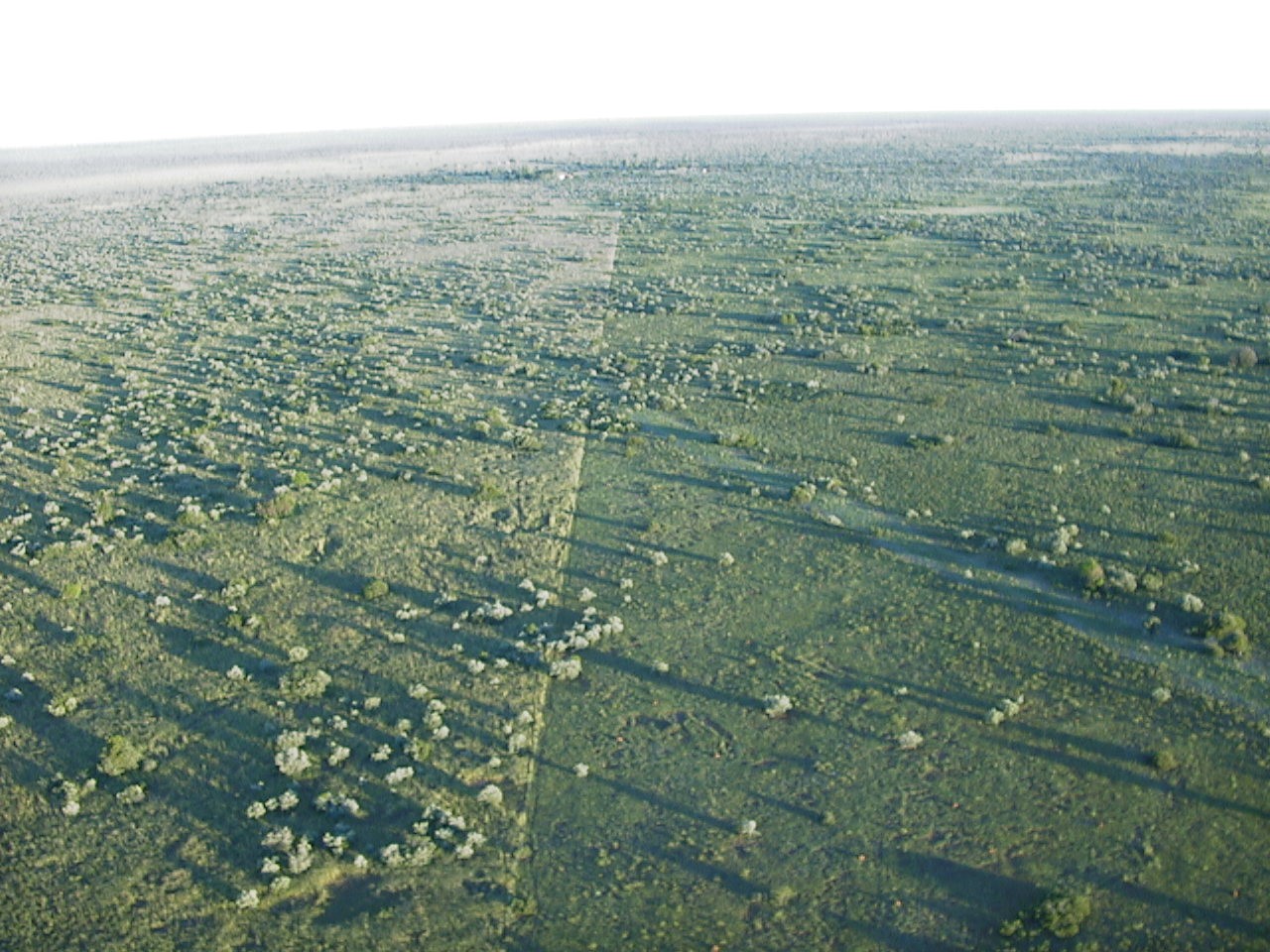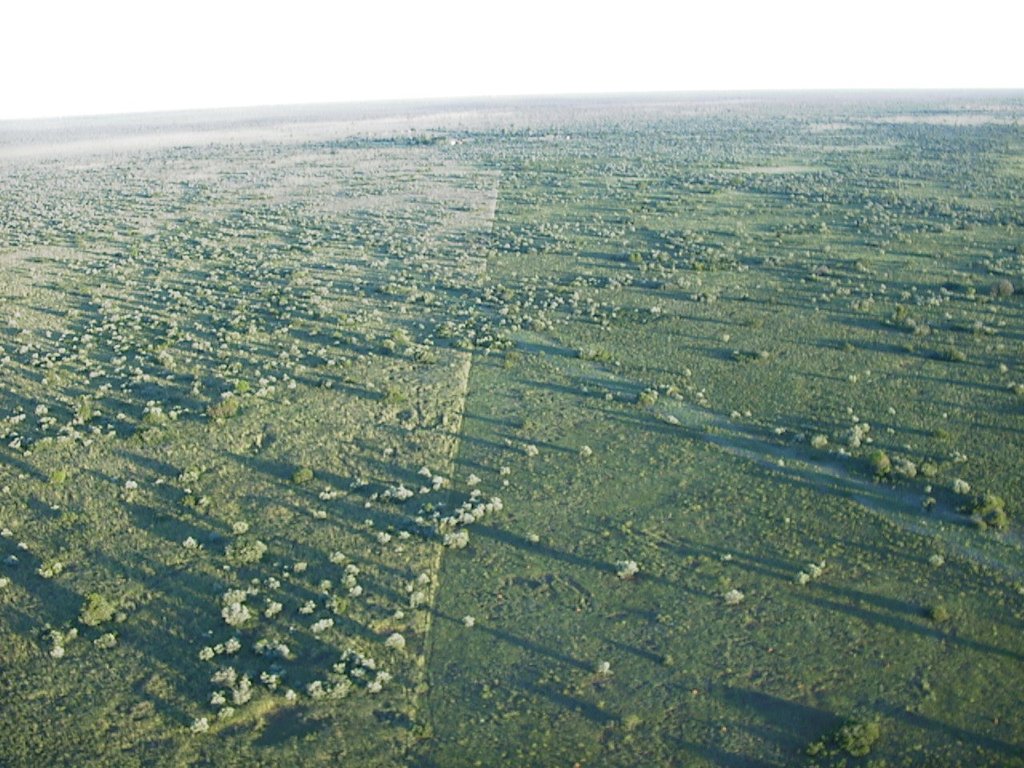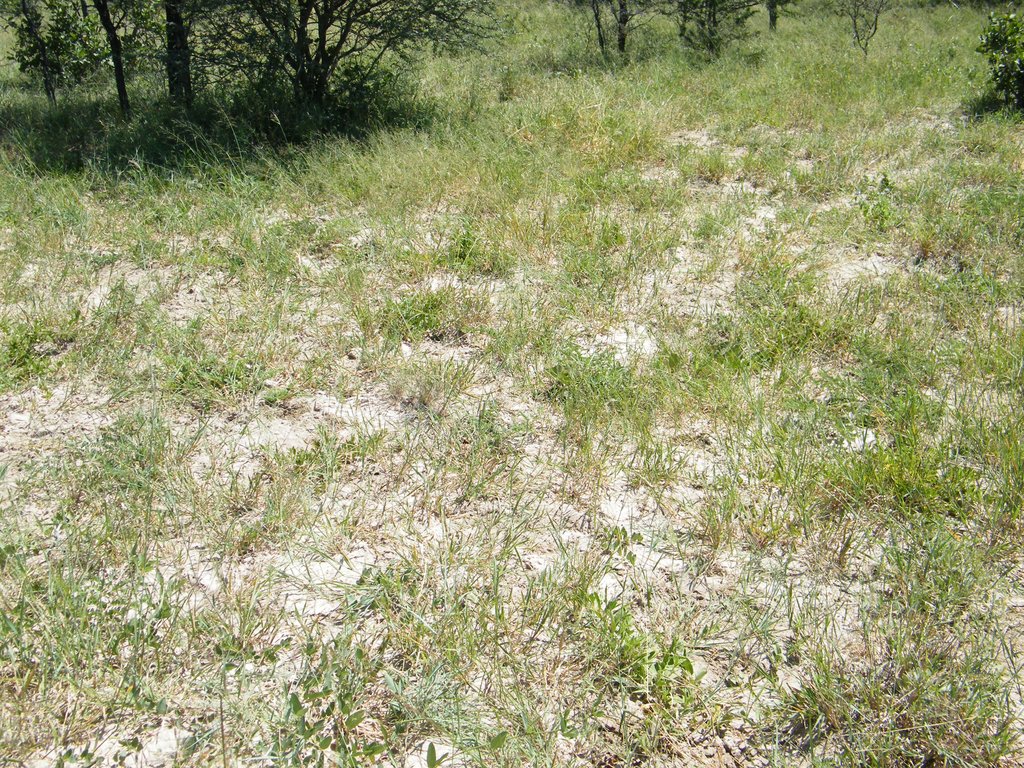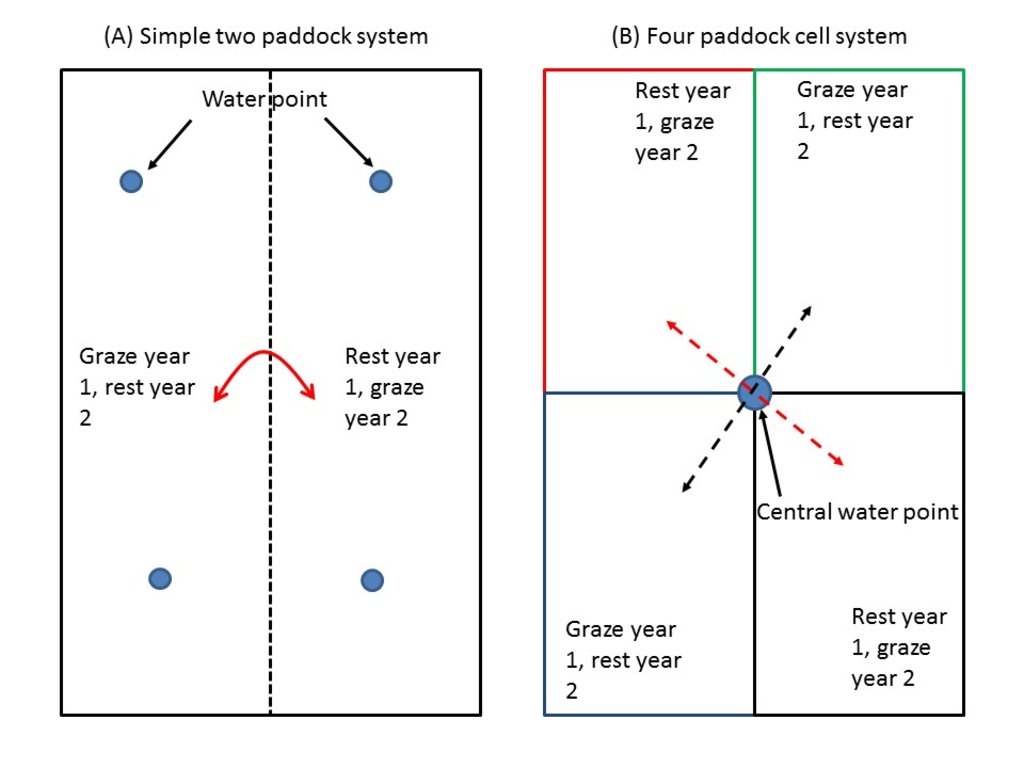Split Ranch Grazing Strategy [博茨瓦纳]
- 创建:
- 更新:
- 编制者: Richard Fynn
- 编辑者: –
- 审查者: Rima Mekdaschi Studer
Riaan Dames Grazing Strategy
technologies_3217 - 博茨瓦纳
- Split Ranch Grazing Strategy: Aug. 10, 2018 (inactive)
- Split Ranch Grazing Strategy: Oct. 22, 2018 (inactive)
- Split Ranch Grazing Strategy: March 7, 2019 (inactive)
- Split Ranch Grazing Strategy: May 13, 2018 (inactive)
- Split Ranch Grazing Strategy: May 22, 2018 (inactive)
- Split Ranch Grazing Strategy: May 23, 2018 (inactive)
- Split Ranch Grazing Strategy: Feb. 26, 2018 (inactive)
- Split Ranch Grazing Strategy: Nov. 2, 2021 (public)
- Split Ranch Grazing Strategy: May 13, 2018 (inactive)
- Split Ranch Grazing Strategy: Jan. 19, 2018 (inactive)
查看章节
全部展开 全部收起1. 一般信息
1.2 参与该技术评估和文件编制的资源人员和机构的联系方式
关键资源人
SLM专业人员:
有助于对技术进行记录/评估的机构名称(如相关)
University of Botswana (University of Botswana) - 博茨瓦纳1.3 关于使用通过WOCAT记录的数据的条件
(现场)数据是什么时候汇编的?:
2017
编制者和关键资源人员接受有关使用通过WOCAT记录数据的条件。:
是
1.4 所述技术的可持续性声明
这里所描述的技术在土地退化方面是否存在问题,导致无法被认为是一种可持续的土地管理技术?:
否
2. SLM技术的说明
2.1 技术简介
技术定义:
Riaan Dames Grazing involves grazing half the available area for a full year, which concentrates livestock density enabling sufficient grazing pressure to maintain the grassland in an immature, high-quality state, while resting the other half for a full year, which allows optimal recovery of plants from the previous full years grazing. The technology allows simplicity and requires less fencing infrastructure than more complex grazing systems, thereby reducing costs and increasing profits without compromising sustainability or ecological function. The technology can also be used under a planned grazing strategy in pastoral-wildlife grazing systems to create heterogeneity for wildlife and livestock.
2.2 技术的详细说明
说明:
The Riaan Dames Grazing Strategy, otherwise known as Split-Ranch Grazing (SRG), was developed by Riaan Dames in the North West province, South Africa, while working for the Department of Agriculture. It is a fundamentally-different technology to grazing management in comparison with popular rotational grazing management systems in many western countries and contains several conceptual advances over rotational grazing systems. One key difference is that SRG provides a full-year uninterrupted recovery period for rangeland after grazing which enables grasses to maximize nutrient recovery over all the main pulses of nutrient mineralization (when microbes break down organic matter in the soil and release nutrients for plant uptake - mineralization occurs in pulses associated with rainfall events) in the early wet season (most nutrient mineralization occurs in the early wet season) and to maximize root growth and associated nutrient storage over the late wet season and early dry season (most root growth occurs in the late wet season/early dry season when plants translocate nutrients from above ground components to below ground components). Optimal recovery periods should ideally, therefore, encompass the full wet season and the early dry season. This is in contrast to rotational grazing systems where recovery and grazing periods are apportioned across the wet season and early dry season, with resting periods likely not falling in key periods of nutrient uptake and root growth. A major problem with having both grazing and recovery periods in the same season is that grassland is able to mature during recovery periods, greatly reducing forage quality and grass growth rates, thereby likely negatively impacting animal production. Another major problem is that complex rotational grazing strategies invest much in a complex and expensive fencing infrastructure. The solution to these problems is to introduce a fundamentally-different strategy to rotational grazing where some paddocks are grazed the whole year to prevent grassland maturation and other paddocks are rested the whole year to optimize recovery. In addition, paddocks should be as few in number and as large in size as is possible to maximize livestock access to functional resource heterogeneity (different types of resources needed by herbivores at different times and for various purposes, which are distributed across landscapes), thereby improving adaptive foraging options for livestock (have greater ability to move across landscapes to reach needed resource types), while also reducing costs of fencing infrastructure establishment and maintenance. Livestock are maintained in the paddocks planned for grazing until the mid-dry season to ensure that grasses in the rested paddocks have completed root growth and ceased all growth (fully rested and recovered). A full years rest allows maximum uptake of nutrients and maximum storage of these nutrients in deep, strong root systems and crowns, and ensures sustainability. Thus when these grasses are grazed in the next season they have not only efficient root uptake of moisture and nutrients from the soil but also can re-allocate nutrients stored in roots to leaf production after each grazing event, resulting in a productive supply of high-quality fresh leaf to livestock over the growing season. Movement of livestock into the year-long rested paddocks halfway through the dry season ensures that they have a large reserve of forage for the dry season. Concentration of livestock on half the available area (half the paddocks are rested and the other half grazed) ensures sufficient grazing pressure to maintain grassland in an immature, high-quality and rapidly-growing state for maximizing forage quality, leaf production and livestock production, which is further enhanced by greater adaptive foraging options in large paddocks. The technology was started in North West province South Africa, and is now being taken up in Botswana and Namibia. A model example is Tiisa Kalahari Ranch in the Ghanzi region of Botswana, run by Mr Kevin Grant. The ranch has been partitioned into several four-paddock cells, each with their own cattle herd. Cattle graze two paddocks while the other two are rested for a full year. Cattle enter the rested paddocks in the mid dry season (July) once forage is depleted in the two grazed paddocks, which have developed a large reserve of forage to sustain the livestock until the rains arrive. This technology (SRG) has been employed at Tiisa for almost six years. The ranch was in a degraded state at the start of the technology owing to decades of poor grazing management by previous owners. Indications are that the rangeland has been steadily recovering with increases in abundance of high-quality grasses. Monitoring programs are being established to monitor the trends in cover of the various grass species over time.
2.3 技术照片
2.4 技术视频
注释、简短说明:
Tour of several ranches using the split ranch grazing strategy: April 2016, North West Province, South Africa. The video was compiled by Ibo Zimmerman.
See https://www.youtube.com/watch?v=9lOAr1RT69M
日期:
2016
位置:
North West Province, South Africa
摄影师的名字:
Ibo Zimmerman
2.5 已应用该技术的、本评估所涵盖的国家/地区/地点
国家:
博茨瓦纳
区域/州/省:
Ghanzi Province
有关地点的进一步说明:
Ghanzi, Tiisa Kalahari Ranch
注释:
Longitude: -21.60026 (decimal degrees)
Latitude: 21.48969
2.6 实施日期
如果不知道确切的年份,请说明大概的日期:
- 不到10年前(最近)
2.7 技术介绍
- Through interaction with Riaan Dames
3. SLM技术的分类
3.1 该技术的主要目的
- 改良生产
- 减少、预防、恢复土地退化
- 保护生态系统
- 结合其他技术保护流域/下游区域
- 保持/提高生物多样性
- 创造有益的经济影响
3.2 应用该技术的当前土地利用类型

牧场
粗放式放牧场:
- 半游牧/游牧
- 经营牧场
主要动物种类及产品:
The technology can be used for ranching cattle, sheep or goats or using planned herding of these livestock types according to the key concepts outlined in the technology. Products would be meat, wool and to a lesser degree, milk.
3.3 有关土地利用的更多信息
该技术所应用土地的供水:
- 雨养
注释:
Mainly rainfed but some irrigation of improved pasture for dry season forage would be fine
每年的生长季节数:
- 1
具体说明:
Mostly one growing season but can be in a bimodal rainfall region
牲畜密度(如相关):
At conservative stocking rates to ensure that animals are able to remain in the planned grazed paddocks until the mid dry season. Stocking rate will depend upon the local rainfall and soils and associated grass production. 10-15ha/ LSU in semi-arid regions
3.4 该技术所属的SLM组
- 畜牧业和牧场管理
3.5 技术传播
具体说明该技术的分布:
- 均匀地分布在一个区域
如果该技术均匀地分布在一个区域上,请注明覆盖的大致区域。:
- 10-100 平方千米
注释:
Not restricted to any size of land - any size ranch
3.6 包含该技术的可持续土地管理措施

管理措施
- M2:改变管理/强度级别
- M4:活动时间安排的重大变化
注释:
It involves grazing management. Managing stocking rate and the time spent grazing or resting a paddock
3.7 该技术强调的主要土地退化类型

土壤水蚀
- Wt:表土流失/地表侵蚀
- Wg:冲沟侵蚀/沟蚀

土壤风蚀
- Et:表土流失

生物性退化
- Bc:植被覆盖的减少
- Bq:数量/生物量减少
- Bs:质量和物种组成/多样性的下降
注释:
Preventing undesirable changes in grass cover and composition
3.8 防止、减少或恢复土地退化
具体数量名该技术与土地退化有关的目标:
- 防止土地退化
- 修复/恢复严重退化的土地
注释:
The key goals are to improve grass composition and cover, reduce soil erosion and to improve livestock production
4. 技术规范、实施活动、投入和成本
4.1 该技术的技术图纸
4.2 技术规范/技术图纸说明
Riaan Dames Grazing Strategy or Split-ranch grazing can be implemented as simply as dividing the ranch into two paddocks with livestock spending alternate years in each paddock (A) or the ranch can be divided up into several cells according to the ranchers needs, such as having to separate breeding herds, bull herds and weaners (B). In scenario A it is important to ensure good water distribution in each paddock to ensure livestock have access to the whole paddock. This simple scenario (A) is ideal for rural development schemes owing to minimal infrastructure costs and is easy for rural communities to implement. Another advantage is that it gives livestock much greater adaptive foraging options with such large paddocks. In scenario B a central water point provides a convenient way of changing the livestock between paddocks. The gates can be left open between diagonal paddocks to allow livestock freedom of access to either of the diagonal paddocks (greater freedom of adaptive foraging) or they can be actively moved between diagonals during the grazing year according to the ranchers decisions. If paddocks are extremely large then other water points should be provided across the paddocks to allow livestock even access to all parts of the paddock.
4.4 技术建立活动
| 活动 | 措施类型 | 时间 | |
|---|---|---|---|
| 1. | Building fences | 结构性的 | At the start |
| 2. | Digging Boreholes | 结构性的 | At the start |
| 3. | Setting up water reticulation and drinking troughs | 结构性的 | At the start |
| 4. | Buildling animal loading facilities | 结构性的 | At the start |
| 5. | Handling of livestock | 管理 | throughout the year |
4.5 技术建立所需要的费用和投入
| 对投入进行具体说明 | 单位 | 数量 | 单位成本 | 每项投入的总成本 | 土地使用者承担的成本% | |
|---|---|---|---|---|---|---|
| 劳动力 | for building fences and animal loading facilities | person days | 100.0 | |||
| 劳动力 | digging boreholes and setting water reticulation and drinking troughs | person days | 100.0 | |||
| 劳动力 | animal handling | person days | 100.0 | |||
| 劳动力 | etc | |||||
| 设备 | vehicles | machine hour | 100.0 | |||
| 设备 | pumps | pieces | 100.0 | |||
| 设备 | drinking droughs | pieces | 100.0 | |||
| 设备 | machines for digging boreholes | machine hour | 100.0 | |||
| 设备 | machines for building animal loading facilities | machine hour | 100.0 | |||
| 设备 | etc | |||||
| 施工材料 | poles for fences | pieces | 100.0 | |||
| 施工材料 | wire mesh for fencens | meters | 100.0 | |||
| 施工材料 | cement for boreholes and loading faclities | kgs | 100.0 | |||
| 施工材料 | water pipes | pieces | 100.0 | |||
| 施工材料 | etc |
4.6 维护/经常性活动
| 活动 | 措施类型 | 时间/频率 | |
|---|---|---|---|
| 1. | Maintenance of fences | 结构性的 | Throughout |
| 2. | Maintenance of water pipes and pumps | 结构性的 | Throughout |
| 3. | Maintenance of vehicles | 结构性的 | Throughout |
| 4. | Animal handling | 管理 | Throughout |
| 5. | Supplementary feeding (if needed) | 管理 | dry season |
4.7 维护/经常性活动所需要的费用和投入(每年)
| 对投入进行具体说明 | 单位 | 数量 | 单位成本 | 每项投入的总成本 | 土地使用者承担的成本% | |
|---|---|---|---|---|---|---|
| 植物材料 | supplementary feed | bale | 1.0 | 9.0 | 9.0 | 100.0 |
| 技术维护所需总成本 | 9.0 | |||||
注释:
Bales of hay cost 7-9 USD in Botswana depending on availability
4.8 影响成本的最重要因素
描述影响成本的最决定性因素:
Fencing and infrastructure have been shown to be major factors increasing establishment and maintenance costs and reducing profits. Thus this technology aims to reduce these costs by having fewer larger paddocks, which also has benefits for the animals. Another major cost is that of supplementary feeding, especially if forage is depleted during the dry season. This technology aims to ensure that a reserve of forage is created for the dry season so that expensive supplementary feeding is not needed during the dry season, and aims to improve the quality of forage during the wet season so that supplementary feeding is not needed for fertility improvement (conception rates of females).
5. 自然和人文环境
5.1 气候
年降雨量
- < 250毫米
- 251-500毫米
- 501-750毫米
- 751-1,000毫米
- 1,001-1,500毫米
- 1,501-2,000毫米
- 2,001-3,000毫米
- 3,001-4,000毫米
- > 4,000毫米
指定年平均降雨量(若已知),单位为mm:
432.00
有关降雨的规范/注释:
Most Riaan Dame Grazing Strategies (RDGS) are applied in semi-arid climates with a long dry season. However, similar technologies have been applied in high rainfall regions with great success. In fact, the relevance of Split Ranch Grazing (SRG) is likely to increase with increasing rainfall because of the greater decline in forage quality as grassland matures in higher rainfall areas; hence the greater need to concentrate grazing pressure to prevent grassland maturation.
注明所考虑的参考气象站名称:
Department of Meteorological Services, Botswana
农业气候带
- 半干旱
Can be operated in semi-arid, sub-humid or humid environments
5.2 地形
平均坡度:
- 水平(0-2%)
- 缓降(3-5%)
- 平缓(6-10%)
- 滚坡(11-15%)
- 崎岖(16-30%)
- 陡峭(31-60%)
- 非常陡峭(>60%)
地形:
- 高原/平原
- 山脊
- 山坡
- 山地斜坡
- 麓坡
- 谷底
垂直分布带:
- 0-100 m a.s.l.
- 101-500 m a.s.l.
- 501-1,000 m a.s.l.
- 1,001-1,500 m a.s.l.
- 1,501-2,000 m a.s.l.
- 2,001-2,500 m a.s.l.
- 2,501-3,000 m a.s.l.
- 3,001-4,000 m a.s.l.
- > 4,000 m a.s.l.
说明该技术是否专门应用于:
- 不相关
关于地形的注释和进一步规范:
Any situation is appropriate
5.3 土壤
平均土层深度:
- 非常浅(0-20厘米)
- 浅(21-50厘米)
- 中等深度(51-80厘米)
- 深(81-120厘米)
- 非常深(> 120厘米)
土壤质地(表土):
- 粗粒/轻(砂质)
土壤质地(地表以下> 20厘米):
- 粗粒/轻(砂质)
表土有机质:
- 中(1-3%)
如有可能,附上完整的土壤描述或具体说明可用的信息,例如土壤类型、土壤酸碱度、阳离子交换能力、氮、盐度等。:
The ranch has deep Kalahari sands in some sections and shallow rocky soils on calcrete in other sections. Nevertheless the technology is appropriate for any soil type
5.4 水资源可用性和质量
地下水位表:
< 5米
地表水的可用性:
好
水质(未处理):
良好饮用水
水的盐度有问题吗?:
否
该区域正在发生洪水吗?:
否
5.5 生物多样性
物种多样性:
- 中等
栖息地多样性:
- 中等
5.6 应用该技术的土地使用者的特征
定栖或游牧:
- 定栖的
- 半游牧的
生产系统的市场定位:
- 商业/市场
非农收入:
- 低于全部收入的10%
相对财富水平:
- 平均水平
个人或集体:
- 个人/家庭
机械化水平:
- 机械化/电动
性别:
- 男人
土地使用者的年龄:
- 中年人
说明土地使用者的其他有关特征:
The technology can be applied under commercial ranching situations using fenced paddocks to control the spatial and temporal distribution of livestock or it can be applied by semi-nomadic pastoralists using planned herding to control the spatial and temporal distribution of livestock.
5.7 应用该技术的土地使用者拥有或租用的平均土地面积
- < 0.5 公顷
- 0.5-1 公顷
- 1-2 公顷
- 2-5公顷
- 5-15公顷
- 15-50公顷
- 50-100公顷
- 100-500公顷
- 500-1,000公顷
- 1,000-10,000公顷
- > 10,000公顷
这被认为是小规模、中规模还是大规模的(参照当地实际情况)?:
- 中等规模的
5.8 土地所有权、土地使用权和水使用权
土地所有权:
- 个人,有命名
土地使用权:
- 个人
用水权:
- 个人
5.9 进入服务和基础设施的通道
健康:
- 贫瘠
- 适度的
- 好
教育:
- 贫瘠
- 适度的
- 好
技术援助:
- 贫瘠
- 适度的
- 好
就业(例如非农):
- 贫瘠
- 适度的
- 好
市场:
- 贫瘠
- 适度的
- 好
能源:
- 贫瘠
- 适度的
- 好
道路和交通:
- 贫瘠
- 适度的
- 好
饮用水和卫生设施:
- 贫瘠
- 适度的
- 好
金融服务:
- 贫瘠
- 适度的
- 好
6. 影响和结论性说明
6.1 该技术的现场影响
社会经济效应
生产
饲料生产
注释/具体说明:
For details see:
Fynn, R.W.S. Kirkman, K & Dames, R. (2017).
饲料质量
注释/具体说明:
Forage quality improved by keeping the grass in an immature state. For details see:
Fynn, R.W.S. Kirkman, K & Dames, R. (2017).
畜牧生产
注释/具体说明:
Benefit from improved forage quality and larger spatial scales for adaptive foraging. For detail see:
Fynn, R.W.S. Kirkman, K & Dames, R. (2017).
生态影响
水循环/径流
水量
注释/具体说明:
Better soil cover and protection
水质
注释/具体说明:
Better soil cover and protection
地表径流
注释/具体说明:
Better soil cover and protection
生物多样性:植被、动物
植被覆盖
生物量/地上C
栖息地多样性
6.2 该技术的场外影响已经显现
旱季稳定可靠的水流
注释/具体说明:
Better grass cover should improve water capture and stream flow
下游洪水
注释/具体说明:
Better grass cover should reduce runoff rates and downstream flooding
下游淤积
注释/具体说明:
Better grass cover should reduce runoff and erosion rates thereby reducing downstream siltation
6.4 成本效益分析
技术收益与技术建立成本相比如何(从土地使用者的角度看)?
短期回报:
积极
长期回报:
积极
技术收益与技术维护成本/经常性成本相比如何(从土地使用者的角度看)?
短期回报:
积极
长期回报:
积极
注释:
This technology aims to reduce infrastructure and maintenance costs by reducing the amount of fencing
It also aims to reduce reliance on supplementary feeding
6.5 技术采用
- 1-10%
如若可行,进行量化(住户数量和/或覆盖面积):
In Ghanzi region of Botswana probably about five ranchers have adopted the technology
在所有采用这项技术的人当中,有多少人是自发地采用该技术,即未获得任何物质奖励/付款?:
- 90-100%
注释:
They have adopted the technology because of seeing the results of those using the technology and from farmers day talks
6.6 适应
最近是否对该技术进行了修改以适应不断变化的条件?:
否
6.7 该技术的优点/长处/机会
| 土地使用者眼中的长处/优势/机会 |
|---|
|
Management complexity is reduced - fewer paddocks and less frequent movement between paddocks |
| Establishment and maintenance costs are lower than complex rotational grazing systems owing to less fencing required. Livestock production increased relative to costs |
| Need for supplementary feed and licks reduced owing to livestock having greater adaptive foraging options |
| Rangeland condition improved |
| Rangeland condition improved - better grass cover and greater abundance of high-quality perennial grasses |
| 编制者或其他关键资源人员认为的长处/优势/机会 |
|---|
|
Conceptually the most robust grazing management technology, Extremely long recovery periods promotes sustainability |
| Low establishment and maintenance costs relative to production |
| Concentration of livestock on half the available area enables sufficient grazing pressure to prevent grassland maturation and loss of forage quality |
| Development of a large reserve of forage for the dry season through season long resting promotes stability and reduces needs for supplementary feeding (increased profits) |
| Very large paddocks combined with minimal forced movement of livestock promotes adaptive foraging options for livestock thereby reducing need for supplementary feeding and licks (increased profits) |
6.8 技术的弱点/缺点/风险及其克服方法
| 土地使用者认为的弱点/缺点/风险 | 如何克服它们? |
|---|---|
| Less intensive management increases predation events on livestock | Herding of livestock |
| 编制者或其他关键资源人员认为的弱点/缺点/风险 | 如何克服它们? |
|---|---|
| Potential over/under use of certain habitat type. Less control of timing and intensity of grazing distribution could result in damage to sensitive habitat types | Monitoring by the rancher of impacts on vegetation and use of water point reticulation/ lick placement/herding to move animals to underutilized areas |
7. 参考和链接
7.1 信息的方法/来源
- 实地考察、实地调查
Many trips to Tiisa ranch to conduct monitoring work
- 与土地使用者的访谈
Have spoken to several land owners using the technology
- 与SLM专业人员/专家的访谈
Have had much interaction with Riaan Dames who developed the technology
7.2 参考可用出版物
标题、作者、年份、ISBN:
Optimal grazing management strategies: Evaluating key concepts Fynn, R.W.S., Kirkman, K.P. and Dames, R. 2017. African Journal of Range and Forage Science 34 (2): 87-98
可以从哪里获得?成本如何?
Taylor and Francis Publishers
标题、作者、年份、ISBN:
Towards optimal rangeland management. Fynn, R.W.S. 2015. Farmers Weekly 18: 56-59
可以从哪里获得?成本如何?
Farmers weekly magazine
7.3 链接到网络上可用的相关信息
标题/说明:
Grazing Strategy of Riaan Dames
URL:
https://www.youtube.com/watch?v=9lOAr1RT69M
链接和模块
全部展开 全部收起链接
无链接
模块
无模块





